Air Quality Monitoring System (Academic Setup, WiFi and GSM enabled) including Sensors
Description
Brand: PValley
Model: AQMS2
Country of Origin: China
Manufacture: Bangladesh
Description:
An Air Quality Monitoring System designed for academic setups, with WiFi and GSM (Global System for Mobile Communications) capabilities, aims to monitor and track various air quality parameters in real-time. It provides an essential solution for studying air pollution and helps in detecting harmful gases and particles
Features:
- Should be a cloud-based air quality monitor that records and displays real-time data for a wide range of parameters, such as particulate matter, pollutant gases, temperature, humidity, and barometric pressure
- With active internet connection, user should be able to monitor this data live finom computer or phone
- The monitoring system should be available with four fundamental sensors: particulate matter, temperature, relative humidity (RH), and barometric pressure (BMP)
- Additionally, it should be supplied with minimum four gas sensors
- Academic configuration should protect vulnerabic populations by monitoring air quality in sensitive environments. Should track gases like Carbon Dioxide (CO2), Carbon Monoxide (CO), Volatile Organic Compounds (VOCs), and Formaldehyde (CH20), promoting better health outcomes.
- It should be meticulously designed to withstand extreme conditions, operate reliably in temperatures as low as -20 °C and humidity levels up to 99%
- Should be suitable for both indoor and outdoor environments
- Integrated locater for maintaining stable temperature, melting snow, ensuring precise measurements.
- Should operate on both WiFi and 4G LTE networks for remote monitoring
- For 4G LTE Network, SIM card should be supplied by the bidder
- Quick setup and intuitive cloud dashboard for easy monitoring
- Should be supplied with 32GB microSD card and cloud storage
- Internal data backup during cloud connectivity interruptions
- Should save data to the SD card, even in offline
- Cloud facility to be used for data access, system updates, and firmware tweaks
- Warnings should be displayed in cloud data for SD or cloud upload issues
- Quick Deployment: Ready to roll right out of the box, This robust system must be delivered as primed for setup in under 15 minutes
- Reliable Performance: Designed for resilience, should guarantee unwavering functionality in temperatures ranging from a chilly-20 to a scorching 50°C.
General Specification:
Body Material:
Printed Front Side Sheet
Sheet Type: Digital
Country of origin: China
Feature:
- Sheet number 26
- Storage Printed temperature 100°c
- Color White/Silver
Hard support board or Plastic Sheet
Sheet Type: Digital
Country of origin: Pakistan
Feature:
- Sheet thickness 10mm
- Two-Part Combination(Transparent/white)
- UV Printout
Panel Box
Brand: Madhav Enterprise
Country of origin: Indian
Features:
- Shape: Rectangular
- Surface Finish: Smooth
- High quality raw material
Best structure
Brand: Altech
Country of origin: Bangladesh
Feature:
- Sheet thickness 5mm
- Sheet (Silver/white)
- Square Shape
Working area:
- Working area: 14* 10 inch
Technical Specifications:
- Particulate Matter Measurements[Winsen-ZH09]:
- Range: 0 to 1000 µg/m3
- Mass concentration measurements of PMI, PM2.5, PM4 and PM10
- Measurement resolution: 1 µg/m3.
- Sensor lifetime:10 years or higher
- Mass concentration accuracy:
- PMI and PM2.5
- 5% (0-100 µg/m3)
- 10% (100 – 1000 µg/m3)
- PM4 and PM10: 25% (0-1000 µg/m3)
- Startup time: <60s
- Response time: <30s
- Acoustic emissions level: 24 dBA at 0.2m
- Long term acoustic emission level drift: +0.5 dB(A)/ yer
- Operating range:
- Temperature: -20 to 50°C
- Relative humidity: 20-99% (non-condensing)
- Barometric pressure: 300-1200 mbar
- Temperature, relative humidity, and barometric pressure measurements[BME-280E]:
- Temperature:
- Measurement range: -40 to 85°C
- Accuracy: Typical ±1°C (0 to 60°C), max. ±0.3°C (-40 to 85°C)
- Resolution: 0.01°C
- Relative humidity:
- Measurement range: 0 to 99% (non-condensing)
- Accuracy: Typical ±1%; max. 2% (0 to 90%) and ±3% (91 to 100%)
- Resolution: 0.01%
- Barometric pressure:
- Measurement range: 300 to 1200 mbar (30 to 120 kPa)
- Accuracy: ±1 mhar (0 to 65°C)
- Resolution: 0.01mbar
- Temperature:
Gas sensors should be included:
Volatile Organic Compound (VOC) [Winsen-ZP101]:
- Sensor output: 0-500 VOC Inder
- Response time (163%): <10S
- Device-to-device variation: +15 VOC Index points
- Repeatability: <+5 VOC Index points
Carbon Monoxide (CO) [Winsen-MEu-CO]:
- Measurement range: 0-1000 ppm
- Maximum overload: 1000 ppm
- Accuracy: ≤ 2ppm
- Response time: <30s
- Repeatability: <1%
- Lower detectable limit (LDL): ≤ 2ppm
- Resolution: 0.1 ppm
- Expected lifetime: >5 years in air
- Cross sensitivity: Hydrogen (20 ppm in 100 ppm concentration)
- Operating Temperature range: -40°C to 55°C
- Operating Pressure range: 800 to 1200 LPA
- Operating humidity range: 15-95%
Carbon Di-oxide (CO2) [Winsen-MH-Z19C]:
- Range: 400-5000 ppm
- Accuracy:
- ….± (50ppm + 2.5% of reading): 400-1000 ppm
- ….± (50ppm + 3% of reading): 1001-2000ppm
- ….± (40ppm + 5% of reading): 2001-5000ppm
- Repeatability: ±10ppm
- Response time: 60s
- Additional accuracy drift after five years: ± (5ppm + 0.5% of reading)
Formaldehyde (CH2O) [Winsen-ZE08-CH2O]:
- Measurement range: 0-5 ppm
- Maximum overload: 10 ppm
- Accuracy: ≤0.05 ppm
- Response time: <120%
- Repeatability: <1%
- Lower detectable limit (LDL): ≤ 0.05ppm
- Resolution: 0.01 ppm
- Expected life time: >3 years in air
- Long-Term Drift: <1%/month
- Operating Temperature range: -20°C to 55°C
- Operating Pressure range: 800 to 1200 PA
- Operating humidity range: 15-95%
- Cross sensitivity:
- Hydrogen Cyanide (<1ppm in 10ppm concentration)
- Hydrogen (3ppm in 100ppm concentration)
- Sulfur Dioxide (1ppm in 10ppm concentration)
- GSM Module [SIM800C]:
- Frequency Bands: 850/900/1800/1900MHz
- GPRS multi-slot class: 12/10
- Dimensions: 17.6*15.7*2.3mm
- Weight: 1.3±0.1g
- Supply voltage: 3.4 ~ 4.4V
- Operation temperature: -40℃ ~85℃
- Compliant GSM phase 2/2+: Class 4 (2W @ 850/900MHz)
- Compliant GSM phase 2/2+: Class 1 (1W @ 1800/1900MHz)
- Control via AT commands (3GPP TS 27.007, 27.005 & SIMCom enhanced AT Commands)
- Low power consumption
- GPRS mobile station class B
- WiFi Module [ESP-8266]:
- Power Supply: +3.3V only
- Current Consumption: 100mA
- I/O Voltage: 3.6V (max)
- I/O source current: 12mA (max)
- Built-in low power 32-bit MCU @ 80MHz
- 512kB Flash Memory
- 8Mbit external QSPI flash memory (1MByte)
- 32-bit Tensilica Xtensa LX106 CPU running 80MHz
- 3V supply (current can spike 300mA+, depending on mode)
- PCB-trace antenna
- 2 x 4 dual-in-line pinout
- Dimensions: 14.3 x 24.8mm
- weight: 1.5g
Power supply and Enclosure:
- Power supply: AC/DC adapter should be included
- Weatherproof enclosure: Protection from rain and sunlight exposure
- The enclosure should have Top cover, Status LED, Air inlet & outlet facility, Sensor probe connector, Power Jack connector etc.
- The status LED blinking should interpret below conditions-
- Initialize device
- Normal Operation
- No internet connection
- Sensor error
- Sensor error
- Internal backup storage is full
Software:
- Connecting computer or phone:
- -Activation of the device by powering it up. Once the LED begins flashing establishment of a connection with a computer or phone will have to be initiated. WiFi settings on computer or phone will have to be accessed and computer or phone will have to be connected using the password as mentioned in the operation manual
- -Upon successful connection, the system configuration panel will automatically launch in a browser window. If the window does not appear automatically, user must Open a browser, enter 192.168.4.1 in the address bar and Press “Go”
- Should click on the “Configure WiFi” function and choosing of WiFi network from the available WiFi networks list
- Configuration:
- Configuration of various settings for the device, such as the device name, user ID or email, time zone, logging interval, and running average for PM data can be done by clicking on Setup
- Device name: The designated name to serve dual purpose: it should be employed in the cloud and also appear as the WiFi name when connecting a phone or desktop for configuration
- Time zone: Selection of the suitable time zone and this setting to be used to record time data within the micro SD card
- Log Interval: This feature should allow users to choose their preferred logging interval, ranging from 15 seconds to 1 hour. Available logging intervals should be 15 sec, 30 sec, 1 min, 5 min, 10 min, 15 min, 30 min and 1 hour.
- Running Average for PM Data: This configuration should determine whether the device should use a running average
- ON: The system should collect PM data every second. Upon logging the data, it should compute the average for the complete interval
- OFF: In this scenario, the system should refrain from averaging the data throughout the entire interval. Instead, it should calculate the average of the data from the last 5 seconds of the logging interval and record that specific value
- Sign in to Cloud:
- Navigation to Cloud Platform via address mentioned in the operation manual. Should come with the landing page that prompts end user for sign-in credentials.
- Dashboard Overview:
- After successfully signing in, end user must be directed to the dashboard of the Cloud Platform
- The dashboard homepage should display a list of connected devices
- Visible connected device should show details such as device name, model number,
- device ID, and subscription information
- Additionally, there should be an option to extend or purchase a subscription by clicking on the “Buy Subscription” button
- Data Summary:
- “Data Logger” tab in the top left corner should be available for the end user so that he/she can view the summary of data for a specific device from the list of connected devices on the cloud platform
- After selecting the desired device, a summary of data must be displayed on the screen which must show the minimum, maximum, and average values of the data stored in the cloud so far
- Continue scrolling should find the graphical representation of data
- Live Monitoring:
- Live data monitoring should also be accessible directly from the dashboard by clicking on the available “Live Data” tab
- Editing Device and Finding Information
- Minimum three icons should be available
- “i” symbol which must be designated for device information. Clicking on it should open a small window displaying device information. End user must also receive the information of current firmware version
- Pen and paper sign icon which is designated for editing the device. From here, end user should be able to modify logger name, set logging intervals, delete the logger, and erase data
- Another icon should be “download data” icon. Clicking on the download icon should. appear a new window from where data downloading can be done by selecting the date and time. Alternatively, data can be downloaded by selecting from the available time durations listed at the bottom of the data downloading window. It should be available in the name of “Quick Download”.
- Data downloading from microSD card w/o removing:
- To do this, user must follow the following steps
- Power off the device if it is currently powered on
- Turn the power back on
- From a computer or phone, search for available WiFi networks
- Look for a network name that starts with the device name and connect to that network
- If prompted, enter the password
- The configuration page should automatically open
- If not, open a browser and type 192.168.4.1 in the address bar
- Click on the “Stored Duta” button
- If a microSD card is present, the files on the microSD card should be displayed on the screen.
- Download the files onto computer or phone using the browser
Lab Observation:
To design and implement an Air Quality Monitoring System that can measure various pollutants, including particulate matter (PM2.5, PM10), harmful gases (CO, CO2, NO2, NH3), temperature, and humidity using sensors. The system will be capable of transmitting data via WiFi to a cloud platform and sending SMS alerts via GSM when certain air quality thresholds are exceeded.
Application in Academic Setup:
- Research: Students and researchers can study the impacts of various factors like weather conditions, traffic, and industrial activities on air quality.
- Teaching Tool: It can be used as a practical example in environmental science or electronics courses to demonstrate how sensors work and how data is transmitted.
- Environmental Awareness: The system can raise awareness about air pollution, providing valuable data for local environmental studies.
- Data for Future Projects: The data collected can be used for further analysis, experiments, or even development of new technologies to combat air pollution.
Accessories:
- Probes and sensors as per configuration,
- Power adapter, Mounting bracket,
- Zip ties,
- Double sided foam tape,
- Screws,
- Micro SD card,
- Royal plugs,
- Printed operation manual etc.
- Instruction Manual
Protection:
Under voltage, Supply over voltage, short circuit, Thermal etc.
Warranty: 1 (One) year with services







Reviews
There are no reviews yet.